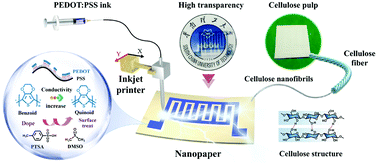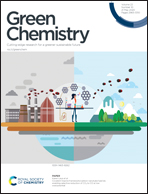Transparent, flexible and recyclable nanopaper-based touch sensors fabricated via inkjet-printing†
Abstract
Transparent, flexible, and eco-friendly touch sensors are important components for next-generation green electronics such as wearable sensors and e-skins. However, most current touch sensors, which are based on plastics or glass substrates and indium tin oxide or metal microelectrodes, are not environmentally friendly, as well as being difficult to recycle and expensive. Here, we demonstrate that a green, transparent, flexible, and recyclable nanopaper-based touch sensor (NPTS) can be fabricated via inkjet printing a conductive polymer, poly(3,4-ethylene dioxythiophene)-doped polystyrene sulfonate (PEDOT:PSS), on cellulose nanofibril paper. The materials cost of a single-keypad NPTS with a size of 3.5 cm × 2.5 cm × 0.05 mm is only $0.060. Good printability, excellent transparency (80% at 400 nm), and high conductivity (1360 S cm−1) were achieved with the PEDOT:PSS microelectrodes when using a newly developed, eco-friendly water-based ink formulation. It takes only 3–4 weeks for the NPTS to degrade completely in natural soil. A four-keypad NPTS was demonstrated by interfacing with the Arduino UNO development board. Folding, bending, and multiple finger-touch trials caused only slight capacitive changes to the NPTS, with no loss of function. The facile fabrication of the NPTS will be invaluable for many practical applications where eco-friendly, transparent, flexible, durable, recyclable, and economical touch-control is required.



 Please wait while we load your content...
Please wait while we load your content...